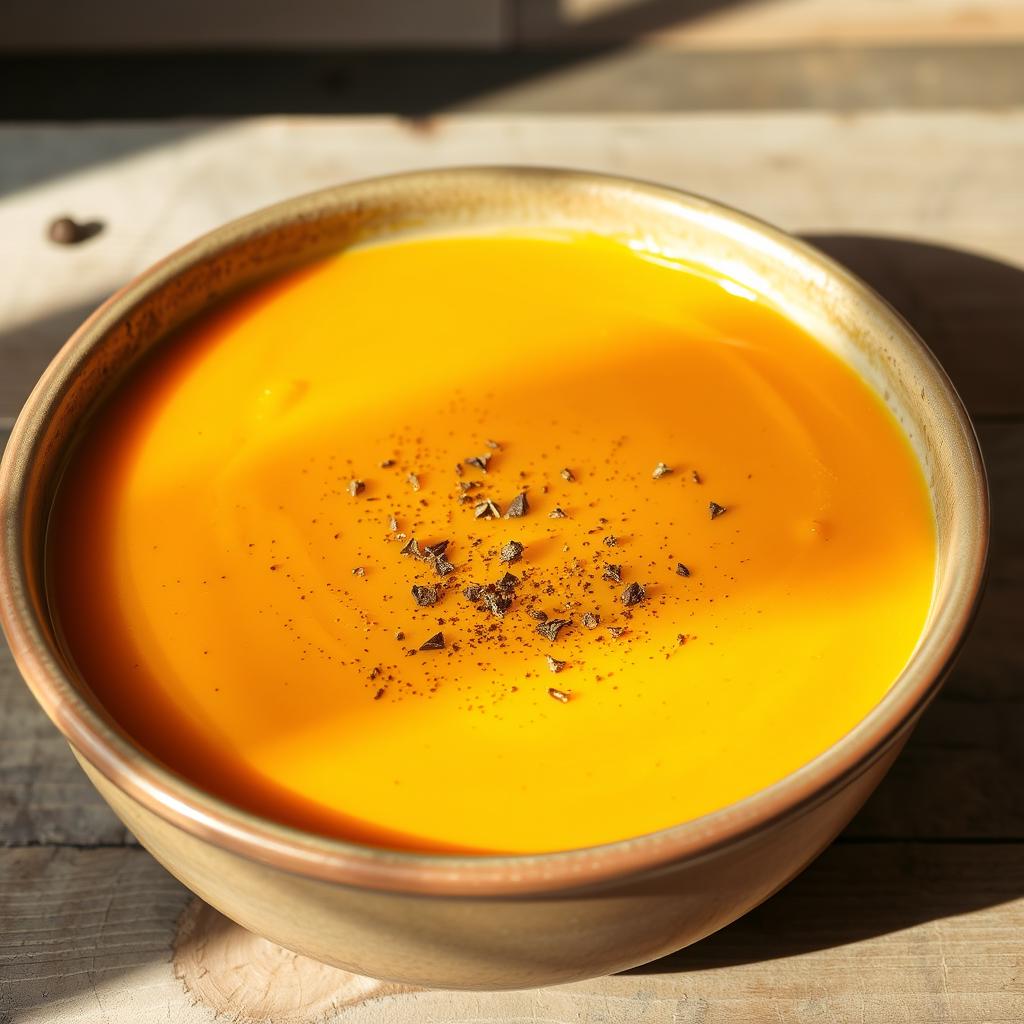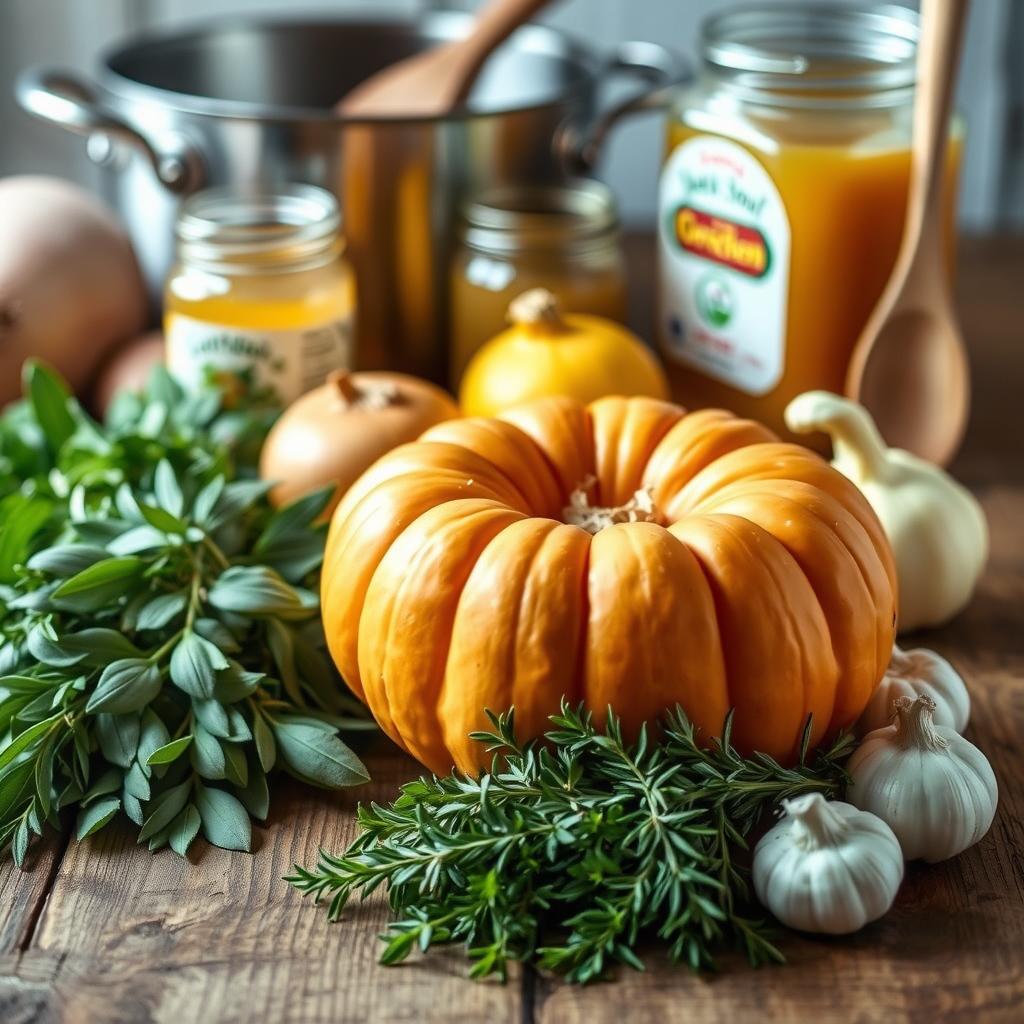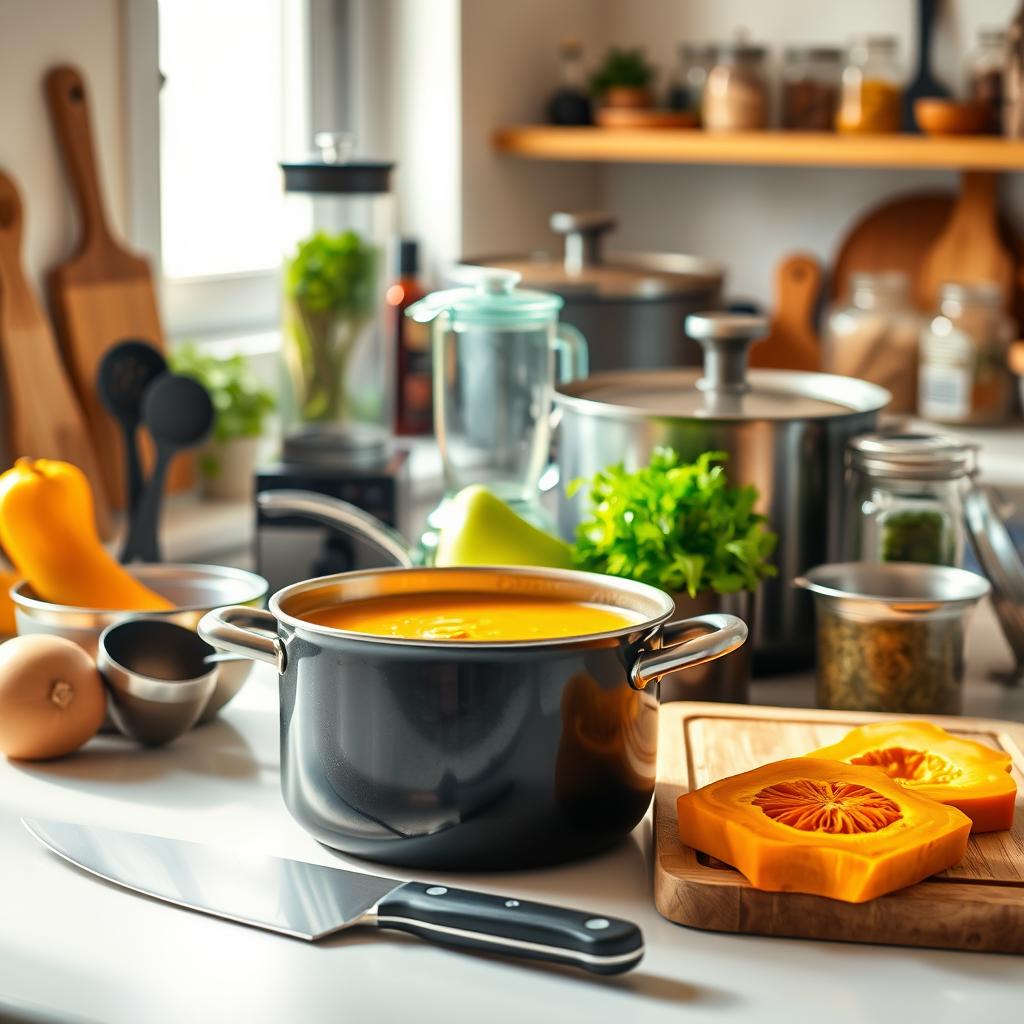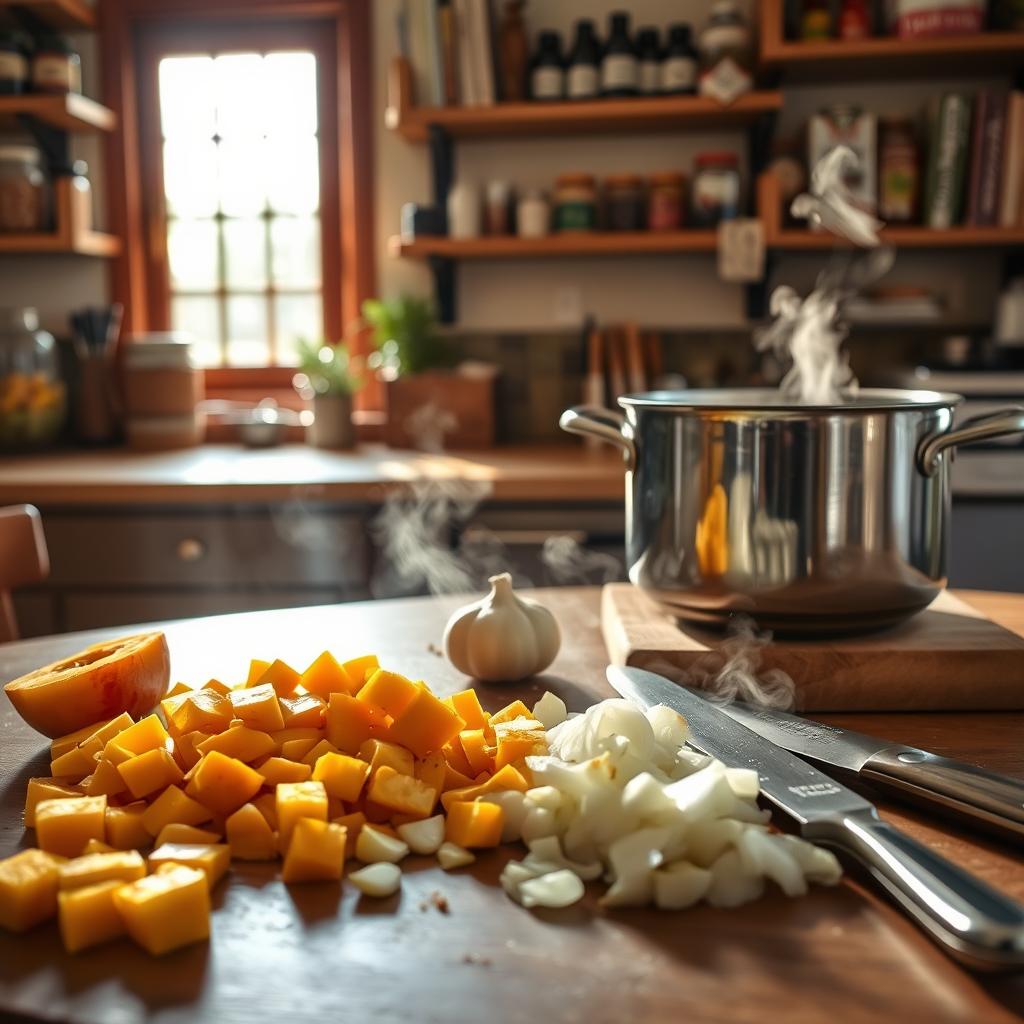There’s nothing quite like a steaming bowl of butternut squash soup to warm you up on a chilly day. This butternut squash soup recipe isn’t just a dish—it’s a cozy embrace in a bowl. It’s perfect for fall recipes, blending the natural sweetness of butternut squash with earthy spices. This creates a comforting meal that’s both simple to make and deeply satisfying. Whether you’re new to the kitchen or a seasoned cook, this homemade soup proves that comfort food doesn’t have to be complicated.

From weeknight dinners to holiday gatherings, this soup adapts effortlessly. Its creamy texture and rich flavor make it a standout comfort food that everyone will love. Let’s dive into how to craft a version that’s as nourishing as it is delicious.
Key Takeaways
- Butternut squash soup is a fall recipes staple, ideal for cold weather.
- Easily adjustable for dietary preferences, using common ingredients.
- A homemade soup that balances simplicity and bold flavors.
- Serves as both a weeknight meal and a sophisticated dinner option.
- Perfect for beginners with minimal kitchen expertise required.
What Makes Butternut Squash Soup a Fall Favorite
There’s something special about fall soup recipes that warms us up. Butternut squash soup is a favorite, blending tradition and taste. It’s a ritual of autumn.
The Rich History of Squash Soups
Indigenous communities in North America grew squash for thousands of years. They used it in stews and broths before European settlers came. These seasonal squash dishes turned into creamy soups we love today.
Food historians say, “Squash’s versatility made it a survival food and a celebration dish alike.”
Why This Soup Became a Comfort Food Classic
This soup has a velvety texture, cinnamon-spiced warmth, and is very nutritious. It’s more than a meal—it’s a sensory hug. Chefs say, “There’s no better way to embrace autumn’s chill than with a bowl that tastes like home.”
Seasonal Benefits of Making This Soup
Autumn is the best time for butternut squash, with fresher ingredients and lower prices. Simmering this fall soup recipes on a crisp day fills homes with cozy aromas. It turns kitchens into havens. It’s no wonder autumn cooking revolves around this dish—every spoonful celebrates the season.
Essential Ingredients for Perfect Butternut Squash Soup
Choosing the right butternut squash soup ingredients is key to a creamy, flavorful soup. Start with a fresh, unblemished squash. Look for ones that feel heavy and have a solid stem.

The soup base components are crucial. Sauté onions and garlic in olive oil for a savory start. Add vegetable or chicken stock for depth. Herbs like thyme or bay leaves add a subtle earthiness. Cream or coconut milk can make it richer.
| Ingredient | Role | Substitutions |
|---|---|---|
| Butternut squash | Core sweetness and texture | Acorn squash |
| Onion | Neutralizes sharpness, balances flavors | Leeks or shallots |
| Vegetable Stock | Liquid foundation | Water + bouillon cubes |
Flavor enhancers like maple syrup or apple pieces add sweetness. Salt and black pepper balance the flavors. Fresh parsley or cilantro add brightness when blended or sprinkled on top. Always taste and adjust as needed.
For a vegan version, use coconut milk instead of dairy cream. Try spices like cumin or smoked paprika to customize the flavor. Each ingredient is important for a comforting and versatile soup.
Kitchen Tools You’ll Need for Preparation
Making perfect butternut squash soup begins with the right soup making equipment. Every kitchen has basic tools that make soup preparation easier. Some tools make things even simpler. Let’s look at what you really need and what’s nice to have.

Must-Have Equipment
First, you’ll need these kitchen essentials:
- A sharp chef’s knife (or a heavy knife for cutting thick squash)
- A sturdy pot (stainless steel or enameled cast iron works best)
- A blender or immersion blender (critical blending tools for smooth results)
Optional Tools That Make the Process Easier
These items are smart upgrades but not required:
- Vegetable peeler for quick squash skin removal
- Rosin pan for roasting squash (adds depth of flavor)
- Chef’s spoon for stirring without scratching pots
Alternatives for Specialized Equipment
Adapt when you’re missing key items:
- Use a manual potato masher to break down cooked squash (texture will be chunkier)
- Substitute a regular spoon for seed scooping if no grapefruit spoon
- Simmer soup in a Dutch oven if lacking a dedicated pot
Creativity is more important than gadgets. Start with the basics and adapt as needed. Your kitchen already has most of what you need!
Step-by-Step Recipe for Classic Butternut Squash Soup
Learning the butternut soup recipe is all about confidence in each step. Follow these easy stages to make a smooth, comforting bowl in no time.

Preparing the Squash
- Cut the squash in half lengthwise and scoop out seeds.
- Microwave cut-side down on a microwave-safe plate for 5 minutes to soften skin.
- Peel cooled squash with a vegetable peeler and dice into 1-inch cubes.
Cooking Techniques for Flavor Depth
Sauté onions and garlic in olive oil until they’re translucent. Add squash cubes and cook until they’re lightly caramelized. Then, deglaze the pan with broth. This step adds layers of taste using basic cooking techniques anyone can master.
Simmering and Blending Soup
Simmer squash and aromatics in broth until they’re tender. Use an immersion blender directly in the pot or work in batches with a countertop blender. Let the steam cool before blending to avoid burns.
Final Seasoning Tips
- Season with salt, black pepper, and a pinch of nutmeg.
- Test the balance by tasting and adjust with lemon juice or cream if needed.
- Top with fresh herbs like parsley or cilantro for a pop of freshness.
Remember: soup seasoning is personal! Taste as you go to make it your own.
Nutritional Benefits of Butternut Squash Soup
Butternut squash soup is more than just a comfort food. It’s a healthy soup benefits powerhouse. Each spoonful is packed with vitamins, fiber, and antioxidants that boost your health. This vitamin-rich soup is full of vitamin A for your eyes and skin, and vitamin C to fight off sickness.

- Vitamin A: 1 cup provides over 400% of your daily needs.
- Vitamin C: Boosts immunity with 50% of daily requirements.
- Fiber: 4g per serving aids digestion and keeps you full.
| Nutrient | Amount per Serving | Health Impact |
|---|---|---|
| Vitamin A | 437% DV | Supports vision and immune function |
| Vitamin C | 44% DV | Collagen production and antioxidant support |
| Fiber | 4g | Regulates blood sugar and aids gut health |
| Calories | 80-100 | Perfect as a low-calorie meal for weight management |
This soup is a butternut squash nutrition superstar. It’s great for gluten-free, vegan, or low-carb diets. Use coconut milk or broth instead of heavy cream to keep it light. Its natural sweetness makes it a favorite, even for those who are picky.
Delicious Variations of Butternut Squash Soup to Try
Ready to explore new flavors? These butternut soup variations and creative soup ideas will make your kitchen a place of discovery. Each recipe adds something new to the classic, from bold to creamy. Let’s look at four standout options:

| Variation Name | Key Ingredients | Notes |
|---|---|---|
| Spicy Butternut Squash Soup | Cayenne, jalapeño, lime | Balance heat with citrus acidity |
| Curry-Infused Version | Curry powder, coconut milk, ginger | Draws on international soup recipes for warmth |
| Creamy Coconut Butternut Soup | Coconut milk, turmeric, black pepper | Swap broth for coconut milk for creaminess |
| Roasted Garlic Combination | Roasted garlic cloves, brown butter | Roast garlic until caramelized for depth |
Spicy Butternut Squash Soup
Add a pinch of cayenne (start with 1/4 tsp) or a diced fresh chili. For a smoky touch, stir in chipotle paste. Always taste and adjust—spice builds as it cools. A squeeze of lime balances heat with brightness.
Curry-Infused Version
Simmer squash with 1-2 tbsp curry powder and grated ginger. Pair with coconut milk for richness. This flavored squash soup gains complexity from turmeric and cumin. Serve with naan bread for dipping.
Creamy Coconut Butternut Soup
Replace broth with full-fat coconut milk. Add 1 tsp ground cinnamon and a pinch of nutmeg. Blend until smooth for a silky texture. Garnish with toasted coconut flakes.
Roasted Garlic and Butternut Combination
Roast garlic cloves in foil until soft. Mash into the soup base before blending. Add a splash of white wine vinegar for tang. The slow roasting intensifies natural sugars.
Creative Garnishes and Serving Suggestions
Make your butternut squash soup stand out with these easy soup garnishes and presentation tips. Whether it’s a cozy dinner or a quick lunch, these serving ideas add flair without extra effort. Discover how small touches can turn ordinary bowls into unforgettable meals.
Crunchy Toppings That Elevate Your Soup
Begin with texture contrasts. Try toasted pepitas, crispy bacon bits, or homemade croutons for a satisfying crunch. A sprinkle of fried sage leaves adds earthy flavor and visual interest. Even crushed tortilla chips can give a southwestern twist. These soup garnishes offer a nice contrast to the soup’s creamy base.
Herb Combinations That Complement the Flavor
- Finely chopped parsley or chives add freshness.
- Dried thyme or rosemary sprinkled at the end enhance savory notes.
- Cilantro pairs well with spicy or coconut-infused versions.
Try different herb combinations to match your soup’s seasoning. Dill is great for light versions, while rosemary is perfect for hearty batches.
Pairing Your Soup with Other Dishes
Balance rich soups with light sides. Serve with crusty sourdough or a tangy apple-cranberry salad. For a full meal, pair with Annie’s Homegrown cornbread mix or a sharp cheddar board. These soup pairings complement the squash’s natural sweetness.
Get creative with presentation: pour soup into hollowed-out acorn squash halves or drizzle with yogurt swirls. Small changes like this can make everyday meals feel special.
Storing and Freezing Your Homemade Soup
Proper soup storage keeps your butternut squash soup fresh and delicious. Cool it down quickly by dividing it into shallow containers. For those who love batch cooking, freezing is essential. Refrigerated soup stays good for 4-5 days. Freeze it in airtight containers for later enjoyment.
Freezing tips: Use rigid plastic or glass containers, leaving space for expansion. Label each container with the date. Here’s why it works:
- Meal prep made easy: Portion into single or family servings for quick weeknight dinners.
- Freeze flat in zip-top bags for space-saving storage.
- Avoid metal containers—they can react with acidic ingredients.
Thaw soups overnight in the fridge or reheat from frozen. Add a splash of broth when microwaving to restore texture. Texture changes? A quick blend after reheating fixes any separation. For freezing soup, glass containers are ideal for long-term storage, while plastic is lighter. Always let soup cool fully before freezing to avoid condensation issues.
“Batch cooking lets you enjoy homemade meals without daily prep—just freeze and go!”
Follow these steps for reliable soup storage. Whether freezing for a week or a month, smart techniques keep your soup fresh. Adjust seasoning post-thaw if needed. With these methods, your batch cooking efforts pay off every time.
Troubleshooting Common Butternut Squash Soup Problems
Even the best recipes can have hiccups. Don’t worry, these fixes turn mistakes into delicious bowls. Learn simple steps to fix every soup.
Fixing a Soup That’s Too Thick or Too Thin
Fixing soup consistency is easy. For thin soup, simmer uncovered until it thickens. Add a diced potato for natural thickness.
Too thick? Stir in broth or water slowly. Use an immersion blender for even texture.
Adjusting Seasoning Issues
Flavors off? Try these fixes: Acidity like lemon or apple cider vinegar can perk up soup. Too sweet? Soy sauce or smoked paprika add depth. Too sharp? Coconut cream can soften it.
Rescuing Burnt or Overcooked Soup
Minor burns? Strain out charred bits. Blend in fresh squash or carrot puree to refresh flavors.
Overcooked and mealy? Thin with broth and add fresh herbs like cilantro or parsley. Always start fresh in a clean pot to avoid smoke odors.
Conclusion
Butternut squash soup is more than just a meal. It’s a celebration of fall’s flavors and the joy of cooking at home. This classic recipe warms us up on cold days, mixing old traditions with new twists like spicy or coconut flavors.
Whether you’re an experienced cook or just starting out, making this soup is a special experience. It turns simple ingredients into something amazing.
Seasonal cooking connects us to nature’s gifts, and this soup showcases butternut squash at its best. It’s not just delicious; it’s also good for your wallet, full of vitamins, and easy to freeze for later. Butternut recipes offer endless creativity, showing that even simple ingredients can be extraordinary.
When you’re feeling down, this soup can bring back memories of cozy kitchens and good times with family. So, grab a butternut squash and start cooking. Let the smell of roasted squash and herbs fill your home. Sharing this dish with others creates lasting memories. Enjoy the journey and the delicious results of your hard work.
FAQ
What is the best way to select butternut squash for soup?
Choose squash that feels heavy and has a smooth, tan skin. It should also have a sturdy stem. Avoid any with soft spots or blemishes for the best taste and texture.
Can I make butternut squash soup in advance?
Absolutely! You can make butternut squash soup ahead of time. Cool it completely before storing in the fridge for up to 4-5 days. Or freeze it for longer storage.
What are some creative ways to garnish my butternut squash soup?
Add toppings like toasted pepitas, crispy bacon, or fried sage. Fresh herbs like cilantro or chives are also great. A swirl of cream or coconut milk can make it look and taste better.
Is butternut squash soup healthy?
Yes, it’s a healthy choice! It’s low in calories and full of vitamins A and C, fiber, and antioxidants. It’s also gluten-free and can be made vegan or low-carb.
What kitchen tools do I need to make butternut squash soup?
You’ll need a sharp knife, a sturdy pot, and a blender. An immersion blender or vegetable peeler can help, but aren’t necessary.
How can I fix a bland butternut squash soup?
Add salt, pepper, spices, or a splash of vinegar or lemon juice to improve the taste. Adding herbs during cooking can also add depth.
How do I store leftover butternut squash soup?
Cool the soup completely and store it in airtight containers. It keeps in the fridge for 4-5 days or can be frozen for up to three months. Label your containers for easy tracking!
Can I add other vegetables to butternut squash soup?
Definitely! Adding carrots, potatoes, or sweet potatoes can enhance flavor and texture. Just adjust cooking time based on the vegetable.
What is the best method for pureeing my butternut squash soup?
An immersion blender works well for pureeing in the pot. You can also use a countertop blender in batches. Be careful of the hot liquid!
Can I make butternut squash soup in a slow cooker?
Yes, you can! Add your ingredients to the slow cooker and cook on low for 6-8 hours or high for 3-4 hours. This method makes the flavors richer.
